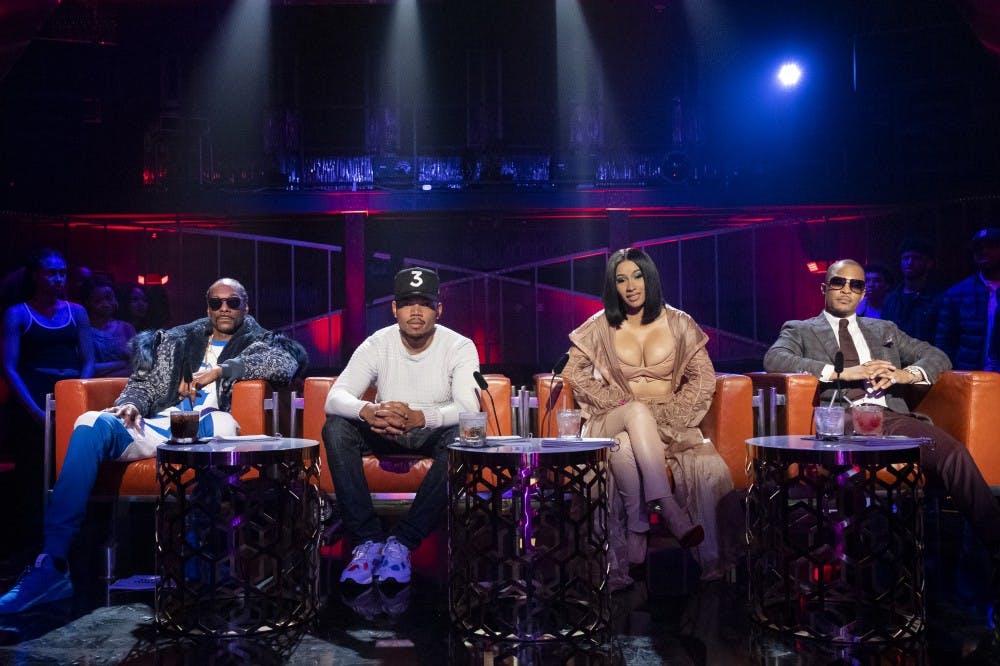Any respectable Millenial–Gen Z cusper has fond childhood memories of watching American Idol back in its heyday. In the emerging world of reality television, the celebrity judges’ state–wide search to find the next pop star dominated the prime time slot. For nearly twenty years it churned out—to the behest of the American public—a number of impressionable entertainers including Kelly Clarkson, Jennifer Hudson, and Carrie Underwood. Since the noughties, the show has lost its luster and programs like The Voice and The X Factor have attempted, and mostly failed, to fill its niche. This is where Netflix’s new series, Rhythm + Flow comes in. In a contemporary pop landscape commanded by rap and hip–hop, a refreshing and enticing televised competition has finally emerged.

Cardi B, T.I., and Chance the Rapper team up to reboot the age–old quest to find the next break–out superstar, hosting a series of auditions in Hollywood and each of their respective hometowns, New York, Atlanta, and Chicago. Within the first sixty seconds of the first episode, T.I. frankly outlines the judges’ mission: “we owe it to ourselves to comb the streets of our own cities.” Each of these cities classifies conveniently as distinct hip–hop meccas. Every episode—masterfully produced by the experts over at Netflix—successfully conveys the judges’ strong connections to their hometowns. This dynamic makes the show feel authentic: Chance the Rapper isn’t just waltzing willy–nilly into the Chicago rap scene—rather, he knows it, respects it, and loves it because it made him the artist he is today. The same goes for Cardi and T.I., who we see flying in on their private jets and immediately making a beeline to their local radio stations to scout the local talent lined up, vying for their attention.

The hunt is on for the complete package of both natural talent and star quality. On one side, we have Chance, claiming to search for “originality, stage presence, lyrical prowess,” all of which we are treated to in bucketloads. On the other is Cardi, who keeps it real with the performers, “Can you sell? Can you get fans? Can you get people to love you?” She’s right: these days, the market is oversaturated with wannabe rappers and their SoundCloud accounts. The game is more complex, nuanced, and profit–driven now than it has ever been, relying heavily on streams and social media clout. The judges ask real questions and the contestants’ talent, passion, and know–how are put to the test. The genuine nature of the show is precisely what makes it worth your time.

Need another reason to tune in? Netflix pulls out all the stops and stacks the show with pure star power, ranging from Snoop Dogg to Anderson Paak to the late Nipsey Hussle. Oh, you’re into Biggie–era, East Coast rap? We’ve got Fat Joe and Jadakiss flanking Cardi’s side as they critique all that the Bronx has to offer. Lupe Fiasco, Twista, and Royce Da 5’9” represent in Chicago, offering wise, respectful, and constructive feedback to kids as young as eighteen—but not before emphasizing the importance of education. In fact, rap education is featured throughout the show, including a class led by Nipsey Hussle at LA’s 1500 Sound Academy and Chance’s homage to the free program that supported his young dreams at Chicago’s Harold Washington Library.

Just like American Idol, the producers highlight the hustle of the contestants, constructing unique narratives that leave the audience invested. Refreshingly, rap and hip–hop is painted in a positive light by the mass media. Rhythm + Flow positions the art form as a healthy outlet for people to express their lives and challenges—specifically those experiencing difficulties, sometimes on the edge of poverty. At times, it can be heart–wrenching to see contestants break down at this opportunity or about the struggles they've gone through. In a way, these competition–style reality shows deeply underscore the very fabric of our society, the American Dream, the tentative assumption that yes, you can “make it” if you hustle, keep your head down, develop your passions, and educate yourself. Each narrative is compelling and eloquently composed, from the father who strives to bring his family out of poverty and chase his aspirations, to the young–adult girl seeking an outlet to express the trauma brought on by her twin brother’s arrest due to racial profiling.

Although it’s having one of its biggest mainstream moments now, hip–hop and rap were originally born in the late 20th century out of the expression of the marginalized, urban, population, mostly African–Americans and Puerto Ricans. For decades, it was tagged by the media as evil, corrupting music. As of right now, half of the songs on the Billboard Top 10 are in the rap and hip–hop genre. Rhythm + Flow embodies the culmination of the fascinating evolution of this art form, from its humble beginnings to the commercial and social success story it is today.
The show is fresh, exciting, and well–executed. For the rap and hip–hop fanatic, it’s like candy, laced with the history of the genre and fortified with both classic and contemporary references. For the average viewer, it’s an enticing, binge–worthy reality TV show, full of star power and raw talent. New episodes are released each Wednesday as the contestant pool is slimmed down through a series of cyphers, music video productions, and a variety of other challenges. Do yourself a favor and binge it because some of these hip–hop contestants are sure to be dominating the airwaves soon enough.







